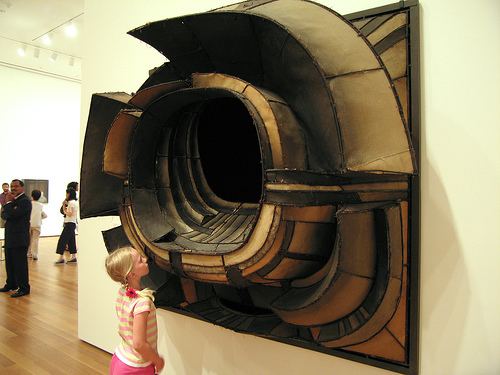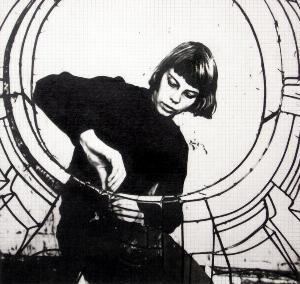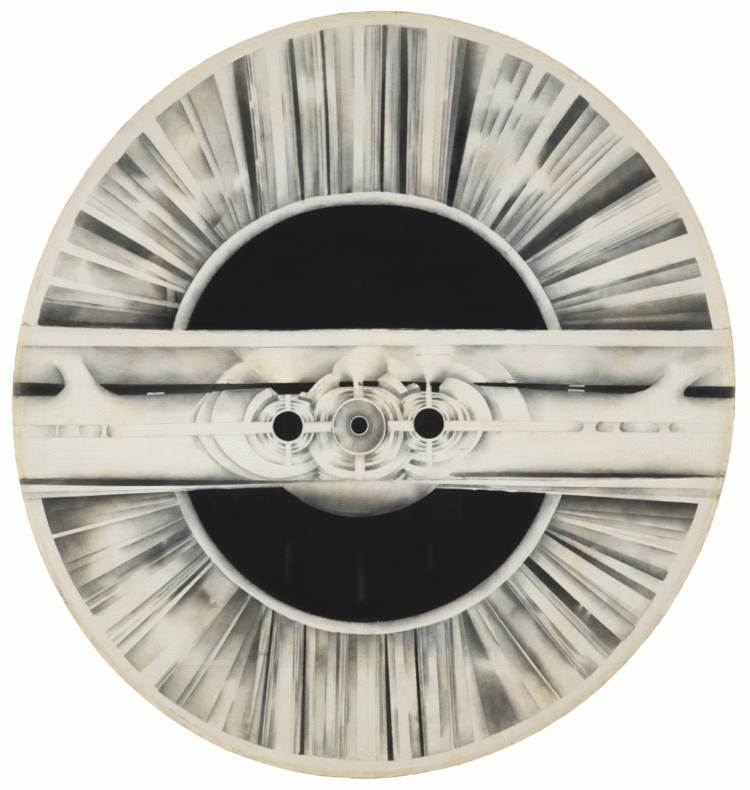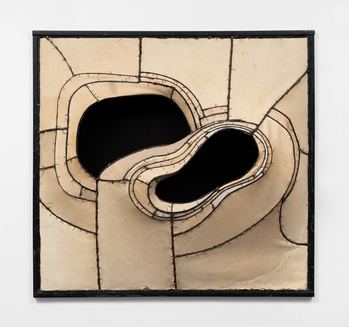Nationality American Name Lee Bontecou | Role Visual artist | |
 | ||
Similar People Louise Nevelson, Eva Hesse, Robert Rauschenberg, John Chamberlain, Jasper Johns | ||
Lee bontecou untitled 1961 moma new york city mov
Lee Bontecou (born January 15, 1931 in Providence, Rhode Island) is an American sculptor and printmaker and a pioneer figure in the New York art world. She kept her work consistently in a recognizable style, and received broad recognition in the 1960s. Bontecou made abstract sculptures in the 1960s and 1970s and created vacuum-formed plastic fish, plants, and flower forms in the 1970s. Rich, organic shapes and powerful energy appear in her drawings, prints and sculptures. Her work has been shown and collected in many major museums in the United States and in Europe.
Contents
- Lee bontecou untitled 1961 moma new york city mov
- Lee bontecou untitled moma new york
- Early life and education
- Career
- Perspective
- Techniques and Materials
- Public collections
- Recognition
- Art market
- Personal life
- Legacy
- References

Lee bontecou untitled moma new york
Early life and education

Bontecou attended Bradford Junior College (now Bradford College) in Haverhill, Massachusetts for her general education and then attended the Art Students League of New York from 1952 to 1955, where she studied with the sculptor William Zorach. She also spent the summer of 1954 at the Skowhegan School of Painting and Sculpture in Maine, where she learned to weld. She received a Fulbright scholarship from the U.S.-Italy Fulbright Commission to study in Rome in 1957-1958. In 1971, she began teaching at Brooklyn College.

Bontecou's work is deeply affected by WWII. Both her parents joined the war effort. Her mother wired transmitters for submarine navigation and her father sold gliders for the military. Growing up, she would spend summers with her grandmother in Yarmouth, Nova Scotia, where she developed a love of the natural world. She had an older brother, Hank.
Career
Bontecou is best known for the sculptures she created in 1959 and the 1960s, which challenged artistic conventions of both materials and presentation by hanging on the wall. They consist of welded steel frames covered with recycled canvas and industrial materials (such as conveyor belts or mail sacks) and other found objects. Her best constructions are at once mechanistic and organic, abstract but evocative of the brutality of war. Art critic Arthur Danto describes them as "fierce", reminiscent of 17th-century scientist Robert Hooke's Micrographia, lying "at the intersection of magnified insects, battle masks, and armored chariots...”. She exhibited at Leo Castelli's art gallery in the 1960s, alongside Jasper Johns, Frank Stella and Robert Rauschenberg. One of the largest examples of her work is located in the lobby of the David H. Koch Theater at Lincoln Center for the Performing Arts in New York City, which was commissioned by the architect Philip Johnson. From the 1970s until 1991 she taught in the Art Department at Brooklyn College.
She continued to teach through the 1990s, while spending time in Pennsylvania. She moved to Orbisonia, Pennsylvania full-time in 1988 where she continues to work. There she maintained a vigorous studio practice, but showed infrequently. She was brought back to public attention by a 2003 retrospective co-organized by the Hammer Museum in Los Angeles and the Museum of Contemporary Art, Chicago, that traveled to the Museum of Modern Art in New York City in 2004. The retrospective included both work from her public, art-world career and an extensive display of work done after retreating from the public view. Bontecou's work was also included in the Carnegie International 2004-5 exhibit in Pittsburgh, Pennsylvania. In 2010, the Museum of Modern Art presented a retrospective of Bontecou's work entitled All Freedom in Every Sense. In 2014, her drawings were exhibited in Lee Bontecou: Drawn Worlds, organized by The Menil Collection, which traveled to the Princeton University Art Museum. Her work was also included in Revolution in the Making: Abstract Sculpture by Women, 1947-2016 at Hauser Wirth & Schimmel in 2016.

In 2017, a major exhibition of Bontecou's drawings and sculpture, including a site-specific installation entitled Sandbox, a collaboration between Bontecou and Joan Banach, was organized by the Gemeentemuseum Den Haag. The exhibition was curated by Joan Banach and Laura Stamps, and accompanied by a fully illustrated catalogue published by Hannibal (Dutch) and Koenig Books, London (English). The catalogue contains new essays on Lee Bontecou by Laura Stamps, Curator of Modern Art at The Gemeentemuseum, Joan Banach, and Jeremy Melius, with an introduction by Gemeentemuseum Director, Benno Tempel.
Perspective

In the 1960s, Bontecou's work was hailed for its unique position in between painting and sculpture. Sculptor Donald Judd wrote that her work "asserts its own existence, form and power. It becomes an object in its own right." The openness, autonomy and engineering processes central to her work, were embraced by the Feminist Art Movement in the 1970s and her use of cavities and holes has been read as female genitalia, and the related, central core imagery. It is an association the artist has denied. Her work has been characterized by references to the synergy between nature and fiction, resulting naturalistically rendered creatures, with grotesquely morphed features.
Techniques and Materials

Lee Bontecou works with many materials, such as metal, paper and plastic. She also works with unconventional materials and discovers new techniques. In her drawings, she developed a process in the late 1950s of using an oxyacetylene torch to produce a carbon spray from the flame, resulting in an "airbrushed" look and deep saturated blacks that she took to her sculptural work.
Public collections

Bontecou's work can be seen in a number of public institutions, including:
Recognition
In 1959, Bontecou received the Louis Comfort Tiffany Award. In 2004, she was elected into the National Academy of Design.
Art market
Bontecou is represented by her sole agent, Bill Maynes.
Personal life
Bontecou is married to the artist William Giles with whom she has a daughter, Valerie.
Legacy
A picture of Bontecou working in her studio, taken by Italian photographer Ugo Mulas in 1963, was used as the cover art for Spoon’s 2007 album Ga Ga Ga Ga Ga. The apparently completed sculpture on the right is now in the collection of the Honolulu Museum of Art.
